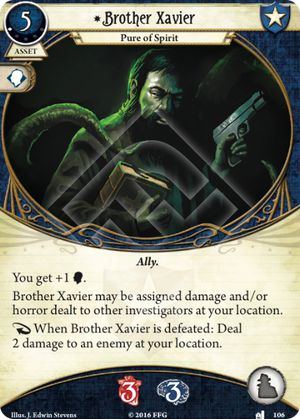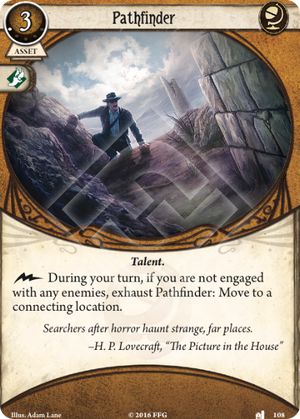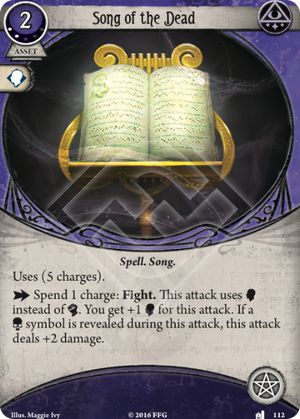Jim is a
very nice fit in the era Arkham Files are set in. A Jazz musician is a very 1920’s
profession and plays on the other side of Arkham Files thematic setting – the feel
of the 20’s. Meanwhile you can also see a clever, subtle connection to Erich
Zann (playing music as a mean to achieve supernatural results). While Agnes’ is
a 100% Mystic, focused purely on spellcasting, Jim shows us a more flexible side
of Mystic characters.
Legacy: Jim was one of very few characters I never ever
used in Arkham Horror. Highly situational abilities and very unfortunate set of
skills made him almost unplayable. An attempt at making him an all-round
investigator was much more successful in Eldritch Horror – he can be easily
adjusted to be a fighter, gate-closer or a spellcaster.
AH:TCG
builds up on existing legacy. It combines both of his AH abilities to create a
new, exceptional and very playable ability. It keeps the theme of
sanity-healing trumpet. And most importantly, it delivers the most successful
attempt at a customisable, all-round character.
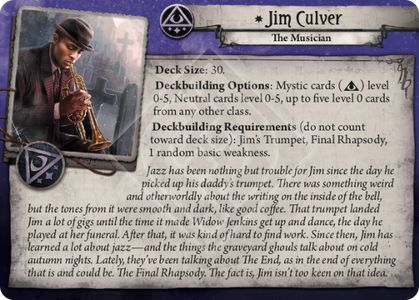 |
| The graveyard background is so well painted. I wish the same one was used for the front of his card |
Skill values: Jim’s skills are completely different than his
Mystic friend’s Agnes’. His Will is not so high, while still good enough to
deliver a decent spell-casting. He can, however, both fight and investigate
without using spells, if needed due to his solid Combat and Intellect. He won’t
be able to manage any of this area as brilliantly, as a specialized guy, but
can cover any of them. His Achilles’’ heel is Agility – making him both
vulnerable to encounter deck and unable to evade enemies. Since Mystics are
capable of covering most aspects of the game with magic, a combination of
natural and supernatural means can be very effective. Unlike Skidds, Jim does
not suffer from lack of specialization.
His skill
values are an important part of Jim’s design. He is a versatile character,
having no obvious weak spots. He can use spells with decent results to deal
with enemies, get clues etc. Unlike Agnes, he can also use more regular means
of archiving the game goals.
Strength
Theme
Special Ability: Jim’s special ability is another piece of the
puzzle. Jim’s distinct capability of treating modifiers on Skull tokens as “0”
has few results. It obviously simply increases chances of passing the tests. Serving
as a slight boost to all his skills, thus enabling him to perform better, even
if he’s skill value is solid only.
More
importantly, however, it encourages playing the odds – one can attempt a skill
check being only at “+1” against the difficulty, or even at “0”, and still have
decent odds at passing the test. Works very well, when planned, still works
solidly when triggered while being confronted with the encounter deck. You
should also take the ability heavily into account, when you create the deck. Don’t
try to overcommit on any particular skill, try to ensure you can always somehow
push your stat 1 above the difficulty and play the odds! This is one of the
abilities, that won’t work on its own – no “autocast” there, you must both well
design your deck and execute it, else it feels like having no special ability
at all!
An integral
part of Jim’s ability is treating Elder Sign as Skulls. It matters for his
signature card, but also opens room for very interesting card design (see: Song of the Dead –and I hope we can expect more of similar cards coming). This
pretty much uses his Elder Sign effect (though you can treat Elder Sign token
as “+1” if needed).
I very much
enjoy the thematic aspect of Jim’s skill. It might not strike you as obvious
(just like the ability of Jim’s fellow Mystic – Agnes), but is an ingenious
design for sure. It is a mix of thematic aspects of Jim’s original special
abilities. First of all, it is a “Strange Luck”, meaning, he is not affected by
negatives circumstances, manages to emerge successful despite them, dodge the ill
effects through unnatural good fortune. And it is “strange” indeed, as it only
affects a very narrow portion of tokens. Furthermore, it is related to his
“monster- taming” ability. Skull tokens tend to be mostly tied with
Enemies/monsters thematically (though, there are exceptions – I wish there were
fewer, to be honest). While it is not directly related to the undead, it is
still a very clear thematic link.
Strength
Theme
Signature Cards: Well, this particular part will be short,
because Jim’s Trumpet is seriously underpowered. Really, not only it’s the
worst signature card so far – I bet (and hope) we won’t see such a weak
signature card ever again. Taking a hand slot to sometimes provide minor sanity
heal is very disappointing. Even taking into account you can use it whenever
ANYONE draws a Skull token (hence in a big team it should get triggered almost
every turn) it still is miles away from other investigators in the signature
card department. Sanity healing for no action is not bad, but taking a hand
slot definitely is too much of an opportunity cost).
The card is
very thematic, that’s true. It feels incredibly personal – musician’s private weapon
instrument of choice It does also a great job, linking all Jim’s designs
across Arkham Files (always a nice touch to have a reoccurring design element).
But at the same time it’s so terribly weak, I only use it to commit to tests.
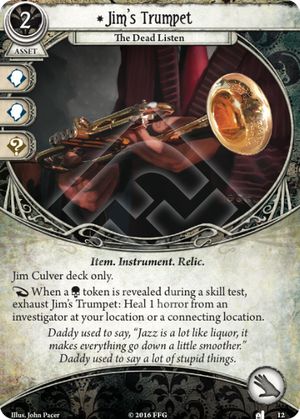 |
| Jim learned how to play a trumpet with one hand and still it's not good enough |
Jim’s
personal weakness is – on the other hand – not too dangerous. If it gets drawn,
it most probably does one damage and one horror (chances of dealing more are
very slim, even with 15 tokens in the bag are around 24%. They are lower than
chances of getting no harm at all!). And that’s it, weakness is gone! The
biggest lost, really, is just getting no useful player card. It is sort of
balanced with his signature card, since it is also the least damaging weakness
out there.
While the
name of the card is nicely connected to Jim’s profession and the Skull tokens
are indeed tied thematically to him, in the end its effect has no relation to its
name.
Strength
Theme
Deckbuilding/Class: Mystic cards allow achieving all sorts
of goals (fighting, investigating, evading, protecting against encounter deck,
gaining resources, healing sanity, even deck manipulation!1) so one
can create a solid deck based on them and even shape it according to your
needs. Jim is very nicely versatile, hence by choosing the right set of cards
outside of his class, you can easily make him a good clue collector (choose DrMilan, Magnifying Glass, Look What I Found! etc), fighter (weapons + PhysicalTraining, helping with both regular attacks and spell casting!) or support
character (Old Book of Lore, some healing cards). At the same time he should be
able to manage his not-strengthened side, due to his special ability. You can
also include Leo in his deck (not only because he’s just strong, but also to
give him one more attempt to gamble against chaos bag). Regardless of the chosen area of focus, Lucky! can always came in handy if you push your luck too much for an important test.
There are
also few Mystic cards, synergizing with his ability – Ritual Candles and
Grotesque Statue encourage and/or help living the risky way.
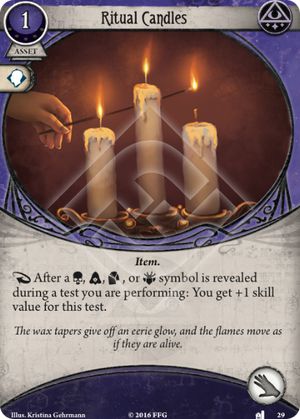 |
| Can you imagine running around with those burning? This is what Arkham investigators do. |
I could
imagine Jim being more inclined to take Rogue or Guardian cards given his
thematic character (he’s leaning towards fighting side of things in Eldritch
Horror), his current deckbuilding options do not create any unthematic
results).
Strength
Theme
Jim seems
not to get too much love among AH:TCG players. He was also reviewed quite
negatively by The Aficionado (https://delvetoodeep.wordpress.com/2017/01/08/delve-too-deep-file-xi-jim-culver/).
I do really like him a lot, though. He can perform strongly in many roles.
He’s not an
auto-play character like Roland or Rex, that’s true. However, this is what
makes playing him is very exciting from the very start – the deckbuilding, as
you can choose multiple viable builds and successfully pair him with basically
any other investigator. Once you start facing the unnatural challenges you keep
balancing the odds pretty much every test, fine-tuning every action between
skill values, Lucky!’s, Grotesque Statue etc. (throw Song of the Dead in the
mix and optimizing gets even more of an interesting challenge!).
I also
cannot agree that’s he’s clearly weaker than Agnes. He’s far less draw
dependent and has far more options open than just casting the spells. While his
ability is not as spectacular, it can be extremely effective in the long run.
Strength
Theme
All images are courtesy of cardgamedb.com and fantasyflightgames.com
1 They lack a powerful, Leo/Beat Cop
(2)/Peter (2) level ally though. Maybe one is to be expected to arrive in the upcoming Mythos Packs?









